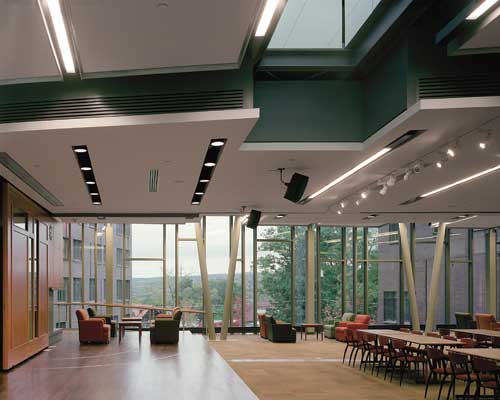Courting Nature in Design
Proximity to nature is potentially unsustainable, such as with unshaded glazing that creates overheating or suburban sprawl in search of meadow views. But it's entirely possible to get the best of both worlds. "Biophilic design involves understanding potential conflicts and achieving the right balance," says Alex Wilson, president of BuildingGreen, LLC, and consulting editor of  GreenSource. "Designers may need to work a little harder to maximize energy efficiency elsewhere in the building to compensate for some energy penalties with biophilic designs, and building owners or developers may have to invest more in ecological restoration and landscaping to turn urban brownfield sites into beautiful biophilic assets, but these are doable."
The connection between biophilia and sustainability has been recognized by the U.S. Green Building Council (USGBC) but, with few exceptions, not yet explicitly incorporated into LEED. In  A National Green Building Research Agenda, revised in February 2008, USGBC explains the delay by noting: "Research is necessary to better characterize these impacts and to quantify specific ways in which site and building design can further promote human health and well-being."
While waiting for researchers to document more quantifiable reasons to design with nature, architects engaged in sustainable design can also incorporate biophilic ideas. This will improve more than our health and well-being. The more we know and love nature, the more likely we are to protect it, which is, after all, the ultimate goal of sustainability.
Staying young in nature
Interest in biophilia has increased recently for several reasons, according to Elizabeth MacPherson, a principal of Seattle-based Mithun. One reason is the accumulation of documented benefits. A second is the growth in urban density, making nature less accessible and forcing designers to be more conscious of creating access. Third is a change of values. With the end of agricultural and industrial economies, she says, we now have an "experiential economy."
 |
Kieran Timberlake designed the Cornell pavilions with ample daylight and views to surrounding hills. Photo © Barry Halkin |
Â
This is illustrated in the recent Mithun-designed health-oriented community in Tucson, Arizona. Decades ago, the company Miraval offered health spas as destination resorts but then found that visitors wanted such places as permanent residences. The Tucson spa-turned-community features amenities to support health and wellness including many forms of nature contact. Although they don't advertise as "senior living," MacPherson reports that most residents are over 55. "I believe there will be a point," she says, "when we'll stop using the term ‘senior housing' and we'll be much more successful. Today's retirement centers got started because it's cost-effective to group the support systems, but I don't think it's socially sustainable." Instead, she says, healthy, active seniors will choose socially diverse projects like Miraval.
In the Tucson project, Mithun designed 26 villas, integrating sustainability with several basic attributes of nature that they use as guiding principles. For instance, they achieve sensory richness through natural materials, including rammed earth walls, which also provide thermal mass for this hot, arid climate, and operable windows providing natural ventilation and smells of the outdoors. The nature attribute of motion appears in the seasonal movement of collected rainwater and in the daily movement of sun dramatized by shadows cast by repeated structural members. A sense of freedom is provided by carefully programmed floor plans that permit eating, sleeping, and even showering both inside and out. Prospect and refuge are provided by the massive walls adjacent to the extensive glazing providing long views out to the desert. Variations on a theme, which distinguish nature from manufactured uniformity, are visible in the patterns of rocks lining basins for collecting rainwater for reuse. An architect schooled in sustainability but not in biophilia might view these features as rapidly renewable materials, passive solar design, and stormwater management, which indeed they are. But they're also creating a sense of well-being that, according to MacPherson, "our bodies respond to, almost at a cellular level."









